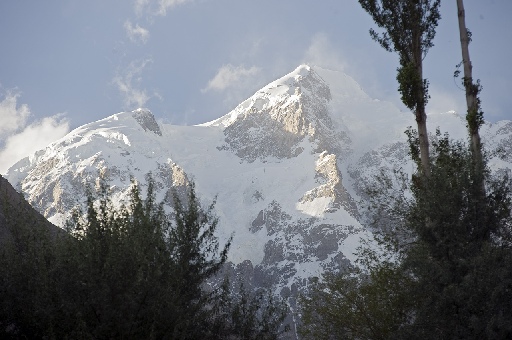|
 Pakistan
is divided into five distinct geographic regions: The Thar Desert and Lower
Indus Valley in the south with arid valleys and rocky hills; The Baluchistan
Plateau toward the west with elevation between 1,000 and 3,000 feet (300-900
meters) and covering nearly half the nation's territory; The Indus Basin, an
irrigated agricultural area in the northeast; The Northwest Frontier, an area
of barren mountains and irrigated valleys bordering Afghanistan; and The Far
North with snowcapped mountains reaching high elevations. Pakistan
is divided into five distinct geographic regions: The Thar Desert and Lower
Indus Valley in the south with arid valleys and rocky hills; The Baluchistan
Plateau toward the west with elevation between 1,000 and 3,000 feet (300-900
meters) and covering nearly half the nation's territory; The Indus Basin, an
irrigated agricultural area in the northeast; The Northwest Frontier, an area
of barren mountains and irrigated valleys bordering Afghanistan; and The Far
North with snowcapped mountains reaching high elevations.
Seasonal temperatures vary widely in these five regions. With the
exception of the Far North, summers are hot throughout the country with
temperatures ranging for 90-120°F (32-49°C) and little nighttime relief.
Trade winds provide some relief during the hot and humid summers in Karachi and a brief cool
season comes between December and February. In Lahore,
Islamabad, and Peshawar
a distinct winter season brings daytime temperatures of 60°F (16°C) or less,
cold nights, and - in Islamabad and Peshawar - frequent
morning frost. Altitude governs climate in the Far North, with pleasant
summers in the lower regions and perpetual snow in the higher mountains.
The average annual rainfall varies from 6 inches (40 cm) in Karachi, 15 (38 cm) in Peshawar,
18 (46 cm) in Lahore, to about 30 (76 cm) in Islamabad. Most rain
falls during the summer monsoon from July to September, although parts of the
Northwest Frontier and the Indus
Basin experience a
moderate winter rainy season as well.
Adventure Travel in
North Pakistan
http://www.kjti.co.uk/
Weather Pakistan Meteorological Department
|
 Pakistan
is divided into five distinct geographic regions: The Thar Desert and Lower
Indus Valley in the south with arid valleys and rocky hills; The Baluchistan
Plateau toward the west with elevation between 1,000 and 3,000 feet (300-900
meters) and covering nearly half the nation's territory; The Indus Basin, an
irrigated agricultural area in the northeast; The Northwest Frontier, an area
of barren mountains and irrigated valleys bordering Afghanistan; and The Far
North with snowcapped mountains reaching high elevations.
Pakistan
is divided into five distinct geographic regions: The Thar Desert and Lower
Indus Valley in the south with arid valleys and rocky hills; The Baluchistan
Plateau toward the west with elevation between 1,000 and 3,000 feet (300-900
meters) and covering nearly half the nation's territory; The Indus Basin, an
irrigated agricultural area in the northeast; The Northwest Frontier, an area
of barren mountains and irrigated valleys bordering Afghanistan; and The Far
North with snowcapped mountains reaching high elevations.